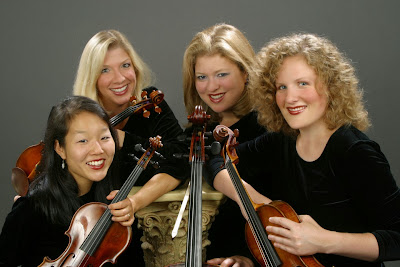Cleveland
Institute of Music
November
22
Cleveland
Museum of Art
November
24
 |
| Expressive players with a passion for their craft. |
The
holiday season brings an explosion of music, in the most literal
sense of the word. Suddenly the concert halls and churches are
bursting with seasonal sing-alongs, boisterous brass and other noisy
Christmas fare. The audiences tend to be just as raucous, primed for
family fun and lacking in concert etiquette.
Fortunately,
there is an alternative for serious music fans. Chamber concerts
attract smaller and smarter audiences, offering refined programming
and an opportunity to see skilled musicians at work close-up. Even
better for aficionados in Cleveland, many of the concerts are free.
The
premier chamber event this month is the Cleveland Institute of
Music’s Winter Chamber Music Festival (more in the sidebar at
right), which kicked off in late November with a performance by the
Cavani Quartet. All faculty members at CIM, the foursome bring an
enthusiasm for their craft to their performances, playing with verve,
intelligence and generosity of spirit.
The
first of their two programs in the festival (the second is on Dec.
11) opened with Mozart’s String Quartet in A major (K. 464).
Beethoven is said to have characterized the piece as Mozart’s way
of saying to the world, “Look what I could produce, if only you
were ready for it.” The quartet did not seem quite ready for it,
playing with precision but none of the lilt that is integral to
Mozart’s music. The form was there but not the substance, a
beautiful shell with no core.
The
mood and period shifted abruptly with the second piece, Bartók’s
String Quartet No. 2. It demands a sharper, energetic approach
that nearly lifted first violinist Annie Fullard out of her seat at
times. Slow to start, the three-movement work picked up drama and
authority as it developed, though didn’t plumb the depths of grief
that Fullard promised in her opening remarks.
Debussy’s
String Quartet in G minor is a seminal work that changed the
rules of chamber music, and the quartet was up to its technical
challenges, slicing off impassioned pizzicato lines, weaving gauzy
textures and putting a glimmering finish on the tender, fleeting
melodies. As a technical showcase, it was a tour de force. The group
showed its lighter side with the encore – “Midnight Child,” a
contemporary piece written for the Cavani Quartet by pianist and
composer Charles Gregory Washington.
We
are in the Year of Italian Culture, which has brought a ton of opera
and great musicians like Maurizio Pollini and Fabio Luisi to American
audiences. For Clevelanders it offered a chance to hear pianist
Antonio Pompa-Baldi – again. He was the winner of the 1999
Cleveland International Piano Competition, has taught at Oberlin, and
is currently a staff instructor at the Cleveland Institute of Music.
 |
| Cultural ambassador. |
The
Italian Consulate co-sponsored his recent recital at the Cleveland
Museum of Art, where Pompa-Baldi presented the program that he played
for the American Liszt Society in San Francisco in June. It was a bit
short on Liszt – only three pieces, one a “paraphrase” of Verdi
– and long on works dedicated to or inspired by Liszt: Chopin’s
Twelve Etudes (Op. 10), and tributes by Russian composer
Sergei Lyapunov and Italian composer Roberto Piana.
The
variety gave Pompa-Baldi a chance to show his considerable technical
prowess. He is a fluent player who blows through complicated passages
with jaw-dropping dexterity – so fast at times that his skill
squeezes his expression. The Chopin Etudes in particular were
beautifully fluid, but played at such an uptempo clip that they lost
their lyrical quality. When Pompa-Baldi slowed down a bit, as in
Liszt’s Ballade #2 in B minor, the music sounded more
sensitive and resonant.
The
performance also had a spoken segment, with the pianist opening the
second half by talking about the program, how he approaches the
pieces, and what he hoped to convey with some of them. After what
seemed like an effortless first half, it was interesting to hear him
reveal the physical strains that some of the pieces impose, and the
ideas behind others. His comments on the closing work, Piana’s
Aprés
une lecture de Liszt (After a reading of Liszt), were
particularly helpful, as it contains some tongue-in-cheek humor that
Pompa-Baldi explained and then executed nicely.
The
concert was part of the Tri-C Classical Piano Recital Series, which
returns to the museum in January. All the performances are free, as
are all the concerts in CIM’s chamber music festival. For edifying
winter warmers, one could hardly do better.
For
more on the Cavani Quartet: http://cavani.org
For
more on Antonio Pompa-Baldi: http://pompa-baldi.com/
Cavani Quartet photo by Christian Steiner
No comments:
Post a Comment